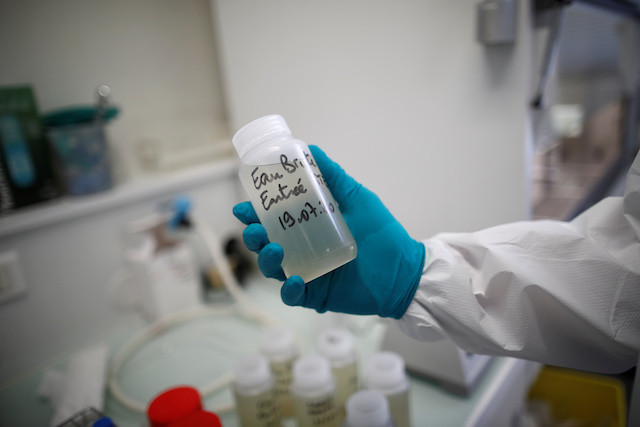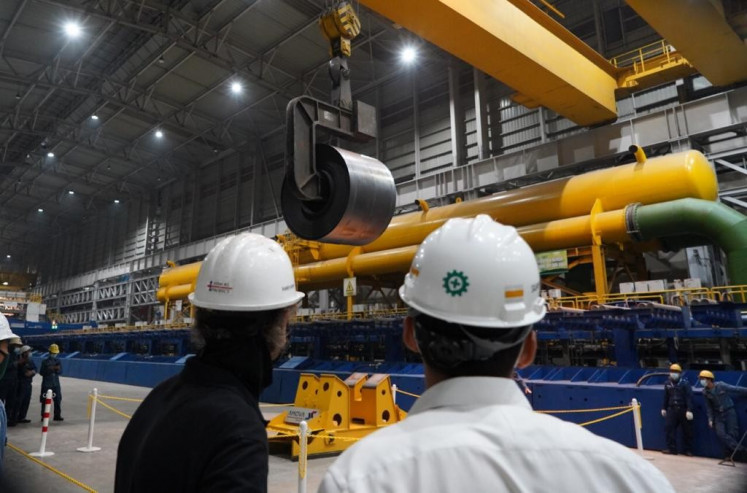Popular Reads
Top Results
Can't find what you're looking for?
View all search resultsPopular Reads
Top Results
Can't find what you're looking for?
View all search results[INSIGHT] Keeping tabs on COVID-19 through sewage surveillance
Amid the shortage of human testing in the early phase, sewage-based surveillance could be chosen as a cheap, noninvasive and sensitive tool to predict the outbreak.
Change text size
Gift Premium Articles
to Anyone
 A water quality scientist holds a water sample at the Eau de Paris research and analysis laboratories in Ivry-sur-Seine near Paris on July 22. Scientists study the Paris waste water to detect the concentration of COVID-19 traces as France remains vigilant regarding the spread of the coronavirus disease. (Reuters/Benoit Tessier)
A water quality scientist holds a water sample at the Eau de Paris research and analysis laboratories in Ivry-sur-Seine near Paris on July 22. Scientists study the Paris waste water to detect the concentration of COVID-19 traces as France remains vigilant regarding the spread of the coronavirus disease. (Reuters/Benoit Tessier)
I
ndonesia has registered 467.113 COVID-19 infection as of Sunday, with a recovery rate of 84.4 percent. The country’s testing rate stands at 18,000 per million residents, according to Worldometers, which is among the lowest in the world and below that of other ASEAN countries.
The low testing capacity has delayed the government response, caused data discrepancy and impeded the country’s capability to detect and diagnose infection cases. Djalante and colleagues found in their study that at the onset of the pandemic in Indonesia, suspected COVID-19 cases were based on just a clinical diagnosis rather than on a polymerase chain reaction (PCR) test, which is considered the gold standard method.
Amid the shortage of testing in the early phase, sewage-based surveillance could be chosen as a cheap, noninvasive and sensitive tool to predict the outbreak. Sebastien Wurtzer, a virologist from Eau de Paris, says the method could help governments forecast a second wave of the outbreak.
Coronavirus shed from infected humans through feces and urine within three days after infection would end up in sewers. The genetic material, namely ribonucleic acid (RNA) of the virus, could be extracted and processed for amplification through PCR to allow detection and quantification of the virus spread.
By using sewage-based surveillance, Wurtzer and colleagues could find high concentrations of SARS-CoV-2 RNA in the sewage before the first day Paris announced multiple deaths from COVID-19. Similarly, in the Netherlands, by examining sewage samples from six cities and the airport, Medema and colleagues found a gene fragment of SARS-CoV-2 RNA weeks before the first case was reported, and the RNA signal increased significantly with the increase in reported COVID-19 cases.
The wastewater-based sampling could even detect asymptomatic people. However, attempts to see what is beyond the surface (e.g., human and clinical data) are apparently lacking in the country’s decision-making process. As of November, the PubMed (collection of multimillion databases containing research articles/journals/report study) has not mentioned any single study on sewage-based surveillance in the country.
“Sewer sampling has the potential to translate the detected viral concentrations into estimates of numbers of infections given in a sewage system’s catchment area,” says Zhugen Yang, a biomedical engineer from Cranfield University’s Water Science Institute in the United Kingdom.
Given its high sensitivity, wastewater sampling can also tell where in the country the disease is still active, says Davey Jones, a professor at Bangor University in Wales, UK.
It also takes only 48 hours from the sample collection to find the results, which equals the time needed to get the results of quantitative PCR-based processing. The implication is, of course, that policymakers can have a head start for a lockdown and conversely ease the lockdown when there is less viral RNA in the sewage.
Wastewater monitoring is not new. According to a 2018 study, Israel was able to detect a silent (caseless) polio epidemic through its sewage/wastewater-based environmental surveillance. Similarly, big cities in the UK like Manchester and Liverpool already took this approach to measure the levels of viral RNA fragments of SARS-CoV-2.
To make things crystal clear, this wastewater-based monitoring for testing is no means to replace the COVID-19 detection in humans in PCR. However, it acts as a cheap warning method for a COVID-19 outbreak. But of course, protective measures and standard protocol needs to be in place for handling the wastewater samples.
Indonesia and the world apparently can’t wait for vaccines to put an end to the prolonged pandemic. With vaccines soon coming, however, we should not underestimate the possibility of COVID-19 reinfection.
“You get it, then after a certain time your body forgets it. Your immune defense will begin to fade, leaving you vulnerable to its return,” former Harvard Medical School professor William A. Haseltine has warned.
In fact, a vaccine does not act like a shield. Instead, it works like an alarm system that helps us make a faster immune response and clear out the virus in a matter of days, rather than weeks, says Haseltine. As a virus mutates, we may need to develop new vaccines, as in the case with flu, or we may need to revaccinate people.
Before the vaccine is finally available, a second wave of coronavirus infections should be anticipated. And even upon arrival of the coveted vaccine, Indonesia in particular still needs more testing, tracking and treating to make sure the virus transmission is declining and eventually brought under control.
--------
The writer is a PhD student in environmental science and engineering at King Abdullah University Science and Technology, Saudi Arabia, and has a master’s degree in environment health and biotechnology from Ghent University, Belgium.









